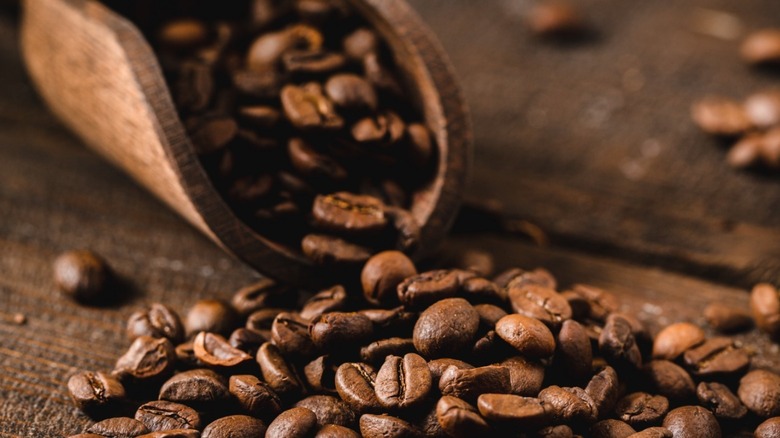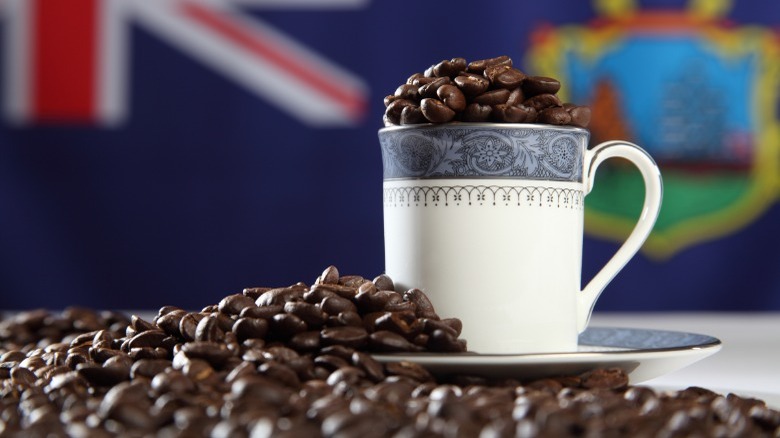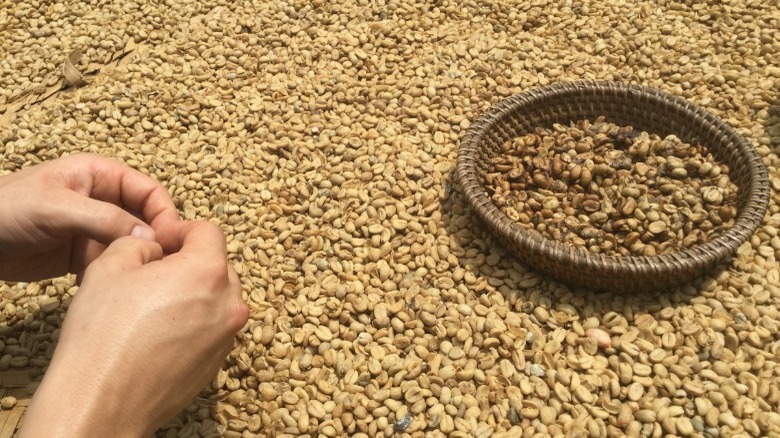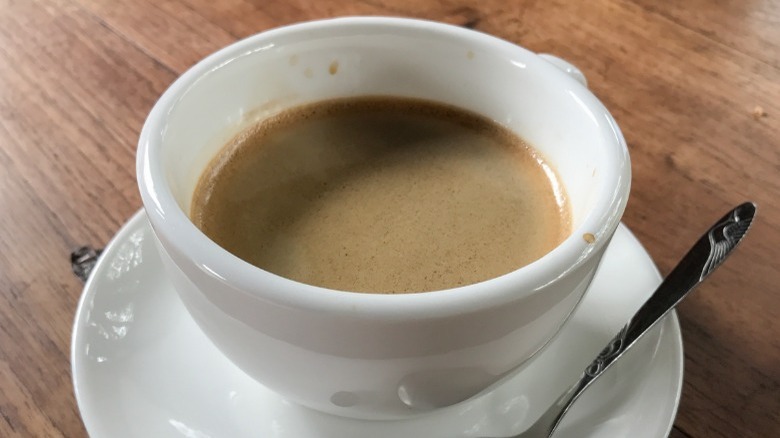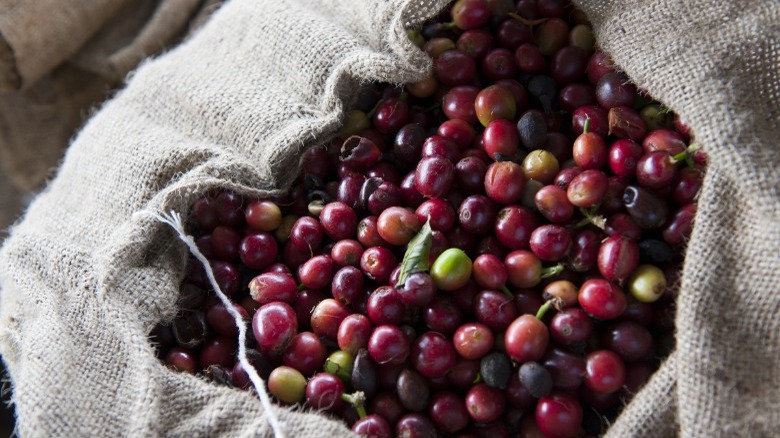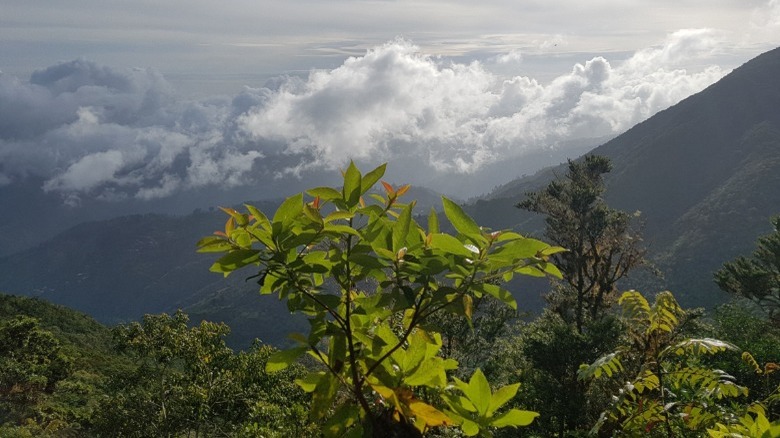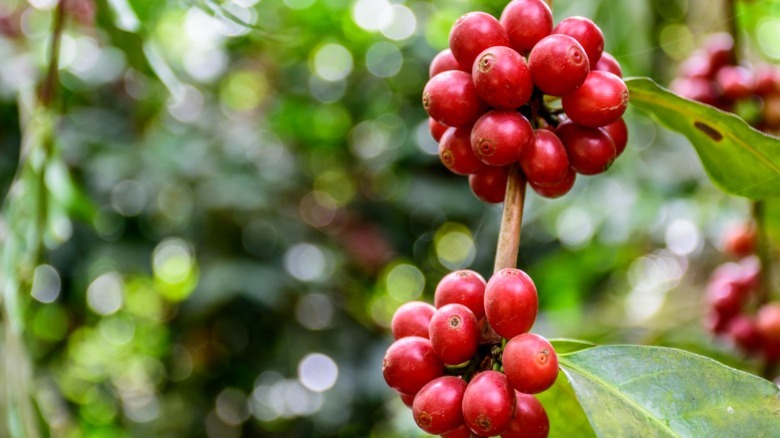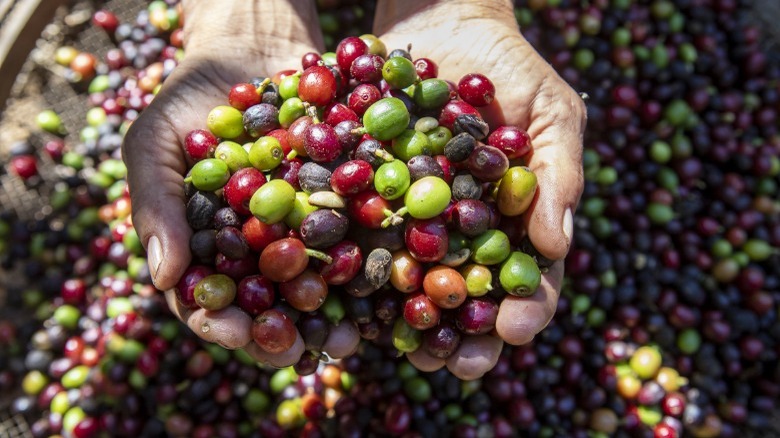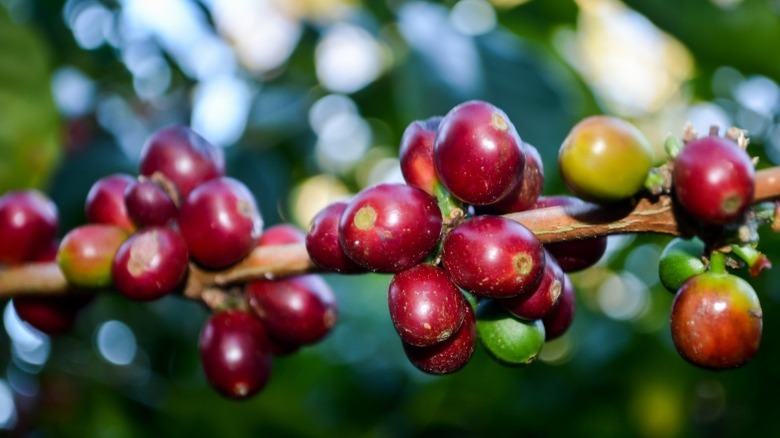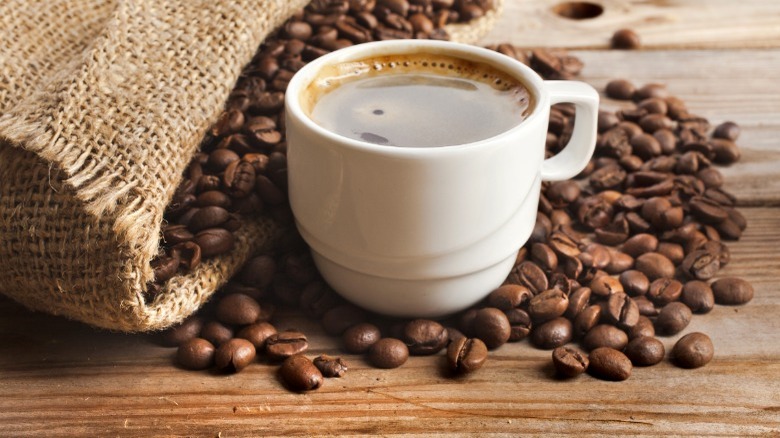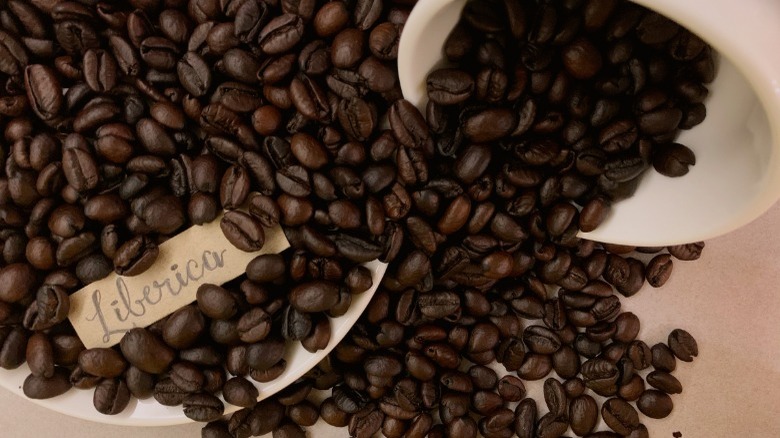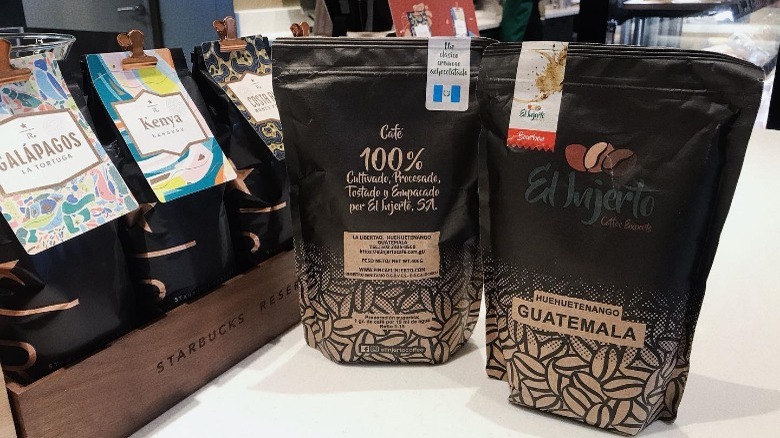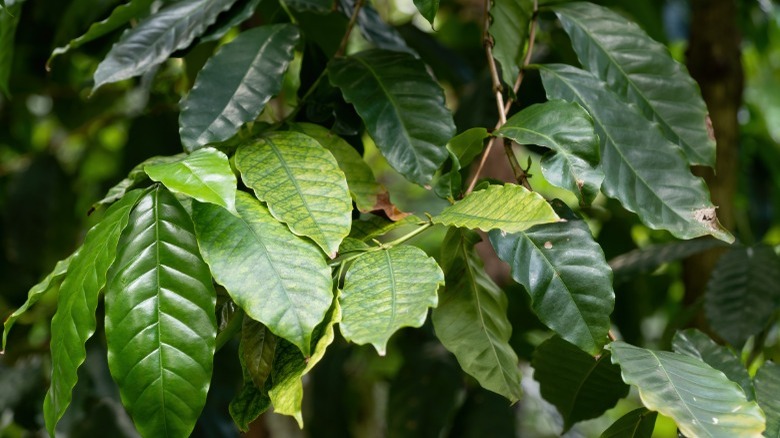12 Rare Types Of Coffee You Have To Try At Least Once
True coffee lovers are generally loyal to their favorite brews but may try other roasts. Real connoisseurs, however, know that there is more to a high-quality coffee bean than the tastes they prefer. These rare coffees prove the point.
What exactly makes a coffee rare? And does that necessarily mean it will be expensive? There are a lot of factors that impact whether or not a coffee bean is difficult to find. The plant may be too delicate to produce an abundance of beans. It may be grown in a hard-to-access environment. Or, it might be the latest offering from an elite, award-winning roaster.
These factors can affect the price of the beans at auction. Yes, they host auctions of rare coffee beans! However, just because a crop of beans goes for a high cost at auction, it may not cost that much for consumers. Here are 12 rare coffee types you should try at least once if you can afford it.
St. Helena Coffee
St. Helena coffee was brought to the island (of St. Helena) in the 18th century and later popularized by Napoleon during his exile there. While the island is accessible, it can only be reached by boat, contributing to its rarity. Exporting this coffee is no easy feat. In spite of this fact, it was enjoyed briefly in Paris and London back in the 1800s.
There is only one kind of coffee bean farmed in St. Helena: arabica. This is a delicate bean that can be difficult to grow and cultivate. It requires a high-altitude plus a blend of ideal conditions to thrive, creating a bean that makes a delicious cup of coffee.
Arabica was officially declared a globally-endangered species in 2019, but that does not hinder its popularity, especially the St. Helena coffee bean derived from the Green Tipped Bourbon Coffee seed. Coffee bean production in St. Helena has peaked and fallen over the years. Most recently, its production is up thanks to Solomon & Company, who own two plantations that grow about 5 tons of beans per year. The taste is distinctive enough that the St. Helena Distillery uses it to create Midnight Mist Coffee Liqueur.
St. Helena coffee's flavor profile is fruity and acidic, with notes of black cherry and chocolate.
Kopi Luwak Coffee
No list of rare coffees is complete without mentioning cat poop coffee, also known as Kopi Luwak. In the 19th century, Dutch colonists blocked the local people in Bali from harvesting their coffee. Native farmers used their ingenuity to find a way around the regulations. They learned that palm civets, or luwak in Indonesian, cat-like creatures, come out at night and eat coffee cherries (immature beans). Their digestive system ferments the cherries, creating viable coffee beans. The farmers then harvested these to produce coffee.
Today, cat poop coffee is more readily retrieved. Coffee farmers cage the civets on their farms to harvest the bean. However, animal rights groups argue that farmers keep these animals in deplorable conditions, such as penning them in tiny cages, force-feeding them, and stripping them of their natural nocturnal lifestyle.
Kopi Luwak is expensive and can cost $400 for 16 ounces. With a controversial and questionable background, there is mixed opinion on the quality of the flavor. We advise avoiding this rare coffee.
Black Ivory Coffee
Black Ivory coffee has been labeled the most expensive coffee in the world. Like Kopi Luwak, this coffee has also been harvested from animal poop — this time from elephants. How exactly do you harvest coffee from elephant poop?
While the standing joke might be "very carefully," Black Ivory does not have the same animal welfare challenges as Kopi Luwak. More than 40 years ago, coffee plantation owners in Thailand noticed that elephants were eating their meticulously cultivated crops. To combat this problem, they decided to feed the elephants coffee beans and harvest them from the poop. Thus, Black Ivory was born. These farmers were focused on treating the animals humanely and keeping them in their natural habitat.
Some people allege that Black Ivory is healthy for you. However, we could find only one study that showed elevated antioxidants in elephant poop coffee, but other coffees showed similar results. With a going price as high as $130 for about 1 1/4 ounces from Black Ivory Coffee Company, there are more cost-effective places to get your antioxidants.
Kona Coffee Beans
Coffee beans grown in the Kona region of Hawaii are all technically under this umbrella. However, there are a few things you should be aware of when seeking the best Kona coffees. Many brands that are labeled "Kona” are actually blends that contain only 10% Kona. Always look for bags that say "100% Kona," which are more difficult to find.
There are more than 500 farms that qualify as Kona coffee bean growers. However, there are also several grades of these beans available. To understand the grades, you must understand the types of coffee. Type I is mid-grade quality, often for restaurants and other commercial uses. Type II is less common. Beans are labeled Type II when one cherry results in only one coffee bean.
Kona grades are separated by type and then determined by quality. Type I is Extra Fancy, Fancy, Kona #1, or Prime in descending grade order. Type II consists only of peaberry coffee beans, which can be stronger than the more common type. It does not, however, necessarily taste better. When drinking true Kona, expect a flavorful, medium roast.
Jamaica Blue Mountain Coffee (JBM)
Jamaican Blue Mountain Coffee dates back to the 18th-century reign of King Louis XV of France. He shipped coffee plants to the French colony of Martinique. A few years later, the governor of Jamaica obtained one of these plants as a gift. It must have been favorably received because, after that, it took off. Grown in the Blue Mountain region of Jamaica, this coffee is desirable and expensive. There are many imposter brands seeking to profit off the name.
So why is Jamaica known for this coffee instead of Martinique? Other beans, such as arabica, are grown in the Jamaica Blue Mountain coffee region. Only JBM also carries the same name, justifying the designation of rare. In addition to being solely grown in a 1.23 square acre location in Jamaica, this coffee is its own variety.
The mountains derive their name from the blue mist that covers them most of the time. While this constant humidity allows for a richer coffee flavor, Jamaican Blue Mountain coffee beans are difficult to farm. It takes 10 months for cherries to ripen, almost twice the time of other plants. Because of the remote location, they also must be hand-picked.
Because there are so many counterfeit versions of this smooth and flavorful coffee, JBM is highly regulated and must feature an official seal of authentication to protect the farmers and coffee drinkers alike.
Guatemala Bella Carmona Coffee
In Antigua, a valley is surrounded by three volcanoes, creating a rich and fertile ground that dwells in the ideal climate for this outstanding coffee. Bella Carmona is grown under strict restrictions by the Zelaya family, who have raised coffee for four generations. This is another coffee grown at incredibly high altitudes, as high as 6,000 feet above sea level.
A painstaking process is used after harvesting this bean, called the washed method. The pulp is removed from the beans, washed, and then set out to dry directly in the sunlight.
The Zelayas are devoted to spreading goodwill by sharing their expertise and teaching local farmers who grow Bella Carmona eco-friendly farming methods. Farmers can also choose to process their cherries at the Zelaya mill.
While arabica is the most common on the farm, Bella Carmona also grows a peaberry coffee bean. This coffee has a flavor profile that includes chocolate, caramel, and orange notes.
Brazil Fazenda Da Lagoa
Fazenda da Lagoa coffee beans have a rich history. Manouel Ferreira Carneiro was one of many Portuguese settlers that came to this region of Brazil. The home he built would be destined to become the site of one of the largest coffee farms in the area and is now co-managed by one of his descendants, Joaquím Paiva.
These beans are grown with a blend of tradition and innovation. Today, the farm combines the latest techniques to promote sustainability with the traditional farming methods used for the last two centuries. This includes feeding the crops with water from more than 40 natural springs and providing a dynamic ecosystem to support and grow these beans. This style of agriculture also protects the future of the farm.
Equally important to management at Fazenda da Lagoa is providing opportunities to the local community. This includes opening the farm to support more than 20 families with work, including work clothes and the ability to receive national healthcare. The farm also offers new coffee professionals the opportunity to grow and expand their expertise in the field.
Panama Geisha/Gesha
This coffee bean has controversy in its background. After winning the Best of Panama award in 2004, it was rediscovered by the coffee world, except it was misnamed "Geisha" rather than the correct name of Gesha. Did the award winners at Hacienda La Esmeralda make a typo?
Not exactly. Panama Gesha coffee beans were named for the town of Gesha, Ethiopia, where they first grew. British explorers exported the plant, eventually bringing it to Panama where it thrived so well that other Central American countries adopted it. Ten years after Hacienda La Esmeralda's bean won, a botanist discovered the link between Geisha and the Ethiopian coffee variety.
Today, most growers in Central America, including Hacienda La Esmeralda, still call this bean Geisha, while in other parts of the world, it is called by its original — and arguably, more accurate name — Gesha.
However it is spelled, the Gesha variety of coffee is unique. Unlike other coffees grown in Panama and other regions of Latin America, Geisha has a more floral and delicate flavor, like many of its Ethiopian counterparts. This unique flavor helped Hacienda La Esmeralda win the World Brewers Cup award in 2021. This is one of the more expensive beans. It has sold for as much as $170 per pound — for unroasted beans!
HR61
Next on our list is HR61, often called the third most expensive coffee in the world since a 2013 auction where it sold for $134 a pound. What's so fascinating about this bean is that its origins are unknown. Initially mistaken for a Gesha, the plant's genealogy did not match that nor any other variety known so far. This did not stop the producers from taking it to auction, where it scored an astounding 94 out of 100, four points higher than any other Gesha that year.
What does it taste like? Farmed at the highly acclaimed Hacienda El Roble, HR61 contains a flavor profile that reads more like a list of essential oils: lavender, bergamot, and lemongrass. It also has notes of black té, green apple, and tropical fruit.
Hacienda El Roble has been dedicated to setting the standard for Colombian coffee for many decades. They create a highly regulated environment that allows them to cultivate this award-winning coffee. Today, you can purchase HR61 for about $35 a pound. That's nowhere near the 2013 auction price, but drinking this coffee is an indulgence.
Liberica Coffee
First harvested in Liberia, liberica coffee is now commonly grown in Southeast Asia. It is one of the four most common coffee bean varieties along with arabica, robusta, and excelsa. If you've heard the term "barako," it refers to liberica beans grown in the Philippines, where their production once thrived.
While these beans are hardier than arabica beans, liberica coffee plants are much larger than most other coffee plants, making it challenging to harvest. Only 2% of coffee around the world is made from liberica. This variety gained popularity when a global fungal infection threatened to wipe out arabica plants in the 1880s.
Unfortunately, after World War II, the Unites States took measures to limit liberica coffee bean production in other countries to promote its coffee interests. These restrictions were lifted in the '50s, but the damage was done. Arabica replaced liberica as the leading variety of coffee.
What does it taste like? Liberica coffee is much stronger than arabica and other coffee types, earning it the nickname "liquid tobacco" to some. However, its caffeine content is lower than other coffees so keep that in mind if you like your shot of caffeine in the morning!
El Injerto
El Injerto coffee, named for the farm that cultivates it, hails from Guatemala and dates back to 1900 when Jesús Aguirre Panamá added coffee bean production to his farm. In 2021, it was named the Best Coffee of Guatemala, no small accomplishment. Today, the same family manages the farm, focusing on modern sustainability practices to cultivate their award-winning beans.
This world-renowned coffee was once a critical global export for Guatemala. Increased coffee production and more local demand have prompted a recent movement to keep these beans close to home. Today, 10% of the output stays within the country. That percentage will grow in the coming years. "Our idea is to continue leaving more coffee here in Guatemala, and export less," says Paulina Aguirre, a family member who manages El Injerto's coffee shop.
El Injerto is lauded with good reason. The El Injerto peaberry bean brew has the rare honor of coming in first at the Cup of Excellence competition for seven straight years. If you're curious about the taste, a sample pack will set you back $299.00.
Highland Coffee from Sierra Leone
This is likely the rarest coffee in the world. Sierra Leone's highland crop has such a low yield that it is unreliable for global distribution. Highland is so rare that it is not for sale.
However, the story is not yet done for this "lost coffee." In the mid-2010s, scientists from Sierra Leone and other international institutions learned about the native bean and, in 2018, set out to find it in the wilds. It took two years to discover enough cherries to make a few cups.
In spite of this, the rare coffee of Sierra Leone may have a bright future. A newly discovered type of coffee there, stenophylla, could help keep the coffee industry running now that arabica is endangered. "The idea is that stenophylla could be used, with minimum domestication, as a high-value coffee for farmers in warmer climates," says botanist Aaron Davis, head of coffee research at Britain's Royal Botanic Gardens.
Stenophylla is likely both heat-resistant and able to withstand common leaf rust, a fungus that attacks coffee plants. This pest has ravaged the coffee bean industry in Central and South America. In other words, this highland coffee could help climate-proof coffee plants for the future.
It's fitting that a rare plant may be the key to future-proofing this commodity that so many countries rely on. We hope they succeed because a future without coffee would be very bleak indeed.

